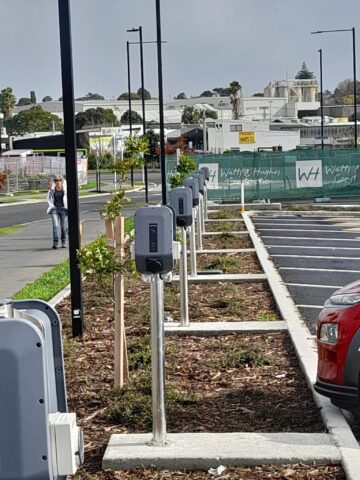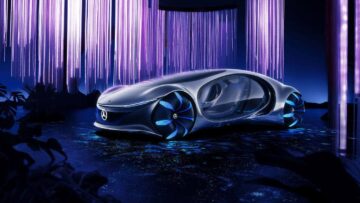The Northern Territory of Australia has long been associated with the biennial World Solar Car Challenge. Solar cars are lightweight EVs powered solely by solar power. They do not access the grid during the challenge.
“The World Solar Car Challenge traverses Australia from Darwin to Adelaide and attracts global expertise in solar and EV technology to the Northern Territory. In recent years, the Challenge has evolved from purely experimental vehicles to include a cruising class which encourages solar cars designed for practicality and aims to change consumer perceptions regarding vehicles and fuels.”
It looks like the race organizers are working with a recent survey showing that a majority (78%) of Territorians would consider purchasing an EV if they were on price parity with petrol or diesel cars — or the developments of solar race cars and consumers EVs are just going hand in hand. Price parity is expected in 2025. But, you say, what of the vast distances. Well, Territorians drive on average 36 km (22 miles) per day, and most of them live in the urban centre of Darwin (capital city of Northern Territory). So, the range of BEVs currently available in Australia (around 300 km) is more than sufficient for average daily trips. Current BEVs are also well able to cope with the extreme climate of the top end.
“In 2019 there were 146 000 light vehicles registered in the Northern Territory and of these, approximately a quarter are smaller, light vehicles (with an engine size less than 2000 cc). These 36 000 smaller light vehicles could potentially be replaced by lower priced EVs which are currently available in Australia.
“Due to distances involved, (EV) technology isn’t there yet for many living and working remote, but no reason why 70 per cent of metro users can’t have at least one (electric) vehicle per family.”
Barriers to uptake included: range anxiety (availability of public chargers), concerns about stress on the grid, battery disposal, availability of service technicians, and, of course, upfront cost.
A comparison between the Nissan Leaf EV and a conventional Corolla reveals that the EV produces around 40 per cent less gCO2/km even when charged from the coal- and gas-fired grid. If charged with renewable energy, EV driving is emission free. The Northern Territory has set a target of 50% renewables in the grid by 2030.
Reforms to Commonwealth regulations regarding “gray” imports may mean a greater availability of second-hand EVs in the latter part of 2022.
“I have a Hyundai Ioniq EV. I find never having to stop at a petrol station convenient. Charging at home is easy. I never need to charge elsewhere. I am able to run out to Howard Springs or Darwin River and back easily without range anxiety. I only need to charge twice a week. An experienced EV owner responded to the survey.”
The Northern Territory government is implementing a plan to address the identified issues. Stamp duty will be reduced by $1500 per vehicle and registration fees will be waived for the first five years. Chargers will be installed in government facilities and there will be a requirement for chargers to be included in new builds. Grants will be issued for charging infrastructure. Plans will be developed by the government to accommodate a greater uptake of EVs (including incentives for daytime charging using solar), the use of electric buses, and V2G technology. Tertiary institutions will be encouraged to offer training courses in servicing EVs and charging equipment (see earlier articles re: TAFE). Information will be provided to consumers on the benefits of EVs, including range, length of charging times, life of an EV, and servicing.
It appears that the Northern Territory government has set quite an aggressive agenda to enable the population to move into the future of motoring. Great to see.
Sources: Electric vehicle strategy and implementation plan, Electric vehicle strategy and implementation plan (PDF), World Solar Car Challenge
Appreciate CleanTechnica’s originality? Consider becoming a CleanTechnica Member, Supporter, Technician, or Ambassador — or a patron on Patreon.


Source: https://cleantechnica.com/2022/01/29/from-solar-race-cars-to-suburban-runabouts-the-northern-territory-ev-transition/
- "
- 000
- 2019
- 2022
- 70
- About
- access
- address
- Advertise
- Anxiety
- around
- articles
- Australia
- availability
- available
- average
- battery
- benefits
- Buses
- capital
- car
- cars
- challenge
- change
- charge
- charged
- charging
- City
- cleantech
- Cleantech Talk
- consumer
- Consumers
- could
- Current
- day
- developed
- developments
- diesel
- driving
- during
- easily
- Electric
- emission
- energy
- equipment
- EV
- expected
- expertise
- family
- Fees
- First
- Free
- future
- Global
- going
- Government
- grants
- great
- Grid
- Guest
- having
- Home
- HTTPS
- Hyundai
- implementing
- included
- Including
- information
- Infrastructure
- institutions
- involved
- issues
- light
- Long
- Majority
- Metro
- more
- most
- move
- Nissan
- offer
- owner
- Patreon
- podcast
- population
- power
- price
- public
- Quarter
- Race
- range
- RE
- registered
- Registration
- regulations
- renewable energy
- Renewables
- Run
- set
- Size
- So
- solar
- Solar Power
- Strategy
- stress
- Survey
- Talk
- Target
- Technology
- The Future
- top
- Training
- urban
- us
- users
- vehicle
- Vehicles
- week
- What
- without
- working
- world
- would
- years









